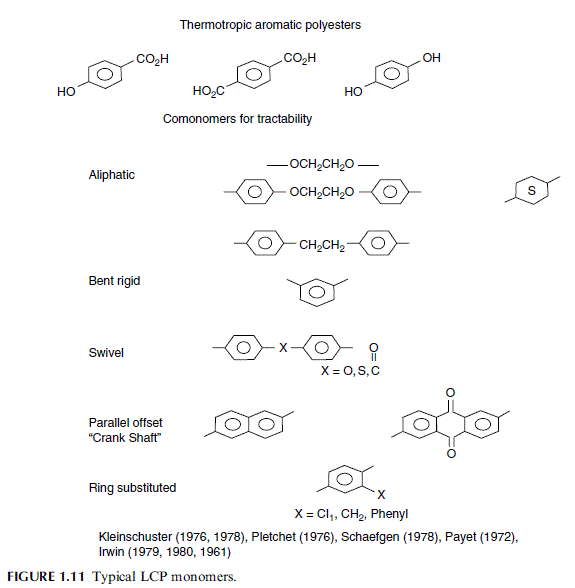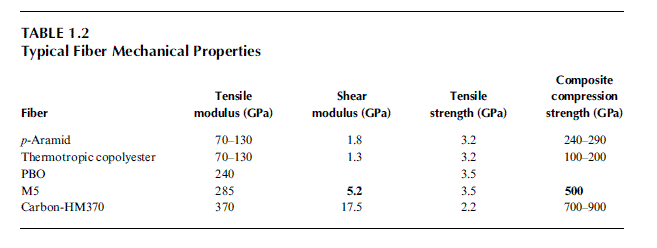Free Textile Article
All about textile & FiberFree Textile Article
All about textile & FiberProcessing of Thermotropic Polyesters
Thermotropic polyesters are melt-spun from the nematic phase and orient easily in an
elongational flow field (moderate drawdowns=forces are sufficient). In the fiber case, highly
oriented fibers form easily with an initial modulus close to theory—typical values range from
about 70 to 150 GPa. Ward [46] has shown that the tensile modulus may be described by an
‘‘aggregate model,’’ i.e., the modulus is a function of the inherent chain modulus, the
molecular chain orientation, and the shear modulus (which described the stress transfer
between chains). The tensile strength of LCP fibers follows the prediction of the ‘‘lag-shear
model’’ [47]. Both the aggregate model and the lag shear model treat the LCP as though it
elongational flow field (moderate drawdowns=forces are sufficient). In the fiber case, highly
oriented fibers form easily with an initial modulus close to theory—typical values range from
about 70 to 150 GPa. Ward [46] has shown that the tensile modulus may be described by an
‘‘aggregate model,’’ i.e., the modulus is a function of the inherent chain modulus, the
molecular chain orientation, and the shear modulus (which described the stress transfer
between chains). The tensile strength of LCP fibers follows the prediction of the ‘‘lag-shear
model’’ [47]. Both the aggregate model and the lag shear model treat the LCP as though it

were a self-reinforced short-fiber-reinforced composite. As-spun tensile strength of the
thermotropic copolyesters tends to be on the order of about 1 GPa, and can be advanced
to about 3 GPa by annealing free to shrink close to the melting temperature. Kinetics of
strength improvement follow those of solid-state polymerization, leading many researchers to
associate strength increases with molecular weight increase [48]. The failure of strength and
elongation to increase in tandem suggests a mechanism of flaw reduction. Structural perfection
and improved intermolecular bonding also play a role in the observed property improvement.
Modulus increase during annealing is usually minimal with the thermotropic polyesters, unless
structural perfection leads to an increase in overall molecular chain orientation.
Structure–Property Relationships
The unifying feature of all fibers spun from LCPs is the very high axial molecular orientation,
which leads to extreme anisotropy of microstructure and mechanical properties. In the
transverse direction, the strength is only about 20% of the axial strength and the modulus is
typically less than 10% of the axial value. The microstructure of LCP fibers reflects the very

high orientational molecular anisotropy, and may be described as a hierarchy composed of
fibrillar structures ranging in diameter from microns to about 10 nm [49,50].
The properties of the most important LCP fibers are listed in Table 1.2. The key
application areas for LCP fibers include hard armor (vehicles, helmets), soft ballistic protection
(vests), cut protection (gloves), and a variety of composite uses that include honeycomb
structure, pressure vessels, and rubber reinforcement. Ropes and cables find utility in the
mooring of huge offshore structures such as oil-drilling platforms and the reinforcement and
support of optical cables. LCP fibers also find specialty niche markets such as sails for racing
yachts, specialized fishing nets, etc.
thermotropic copolyesters tends to be on the order of about 1 GPa, and can be advanced
to about 3 GPa by annealing free to shrink close to the melting temperature. Kinetics of
strength improvement follow those of solid-state polymerization, leading many researchers to
associate strength increases with molecular weight increase [48]. The failure of strength and
elongation to increase in tandem suggests a mechanism of flaw reduction. Structural perfection
and improved intermolecular bonding also play a role in the observed property improvement.
Modulus increase during annealing is usually minimal with the thermotropic polyesters, unless
structural perfection leads to an increase in overall molecular chain orientation.
Structure–Property Relationships
The unifying feature of all fibers spun from LCPs is the very high axial molecular orientation,
which leads to extreme anisotropy of microstructure and mechanical properties. In the
transverse direction, the strength is only about 20% of the axial strength and the modulus is
typically less than 10% of the axial value. The microstructure of LCP fibers reflects the very

high orientational molecular anisotropy, and may be described as a hierarchy composed of
fibrillar structures ranging in diameter from microns to about 10 nm [49,50].
The properties of the most important LCP fibers are listed in Table 1.2. The key
application areas for LCP fibers include hard armor (vehicles, helmets), soft ballistic protection
(vests), cut protection (gloves), and a variety of composite uses that include honeycomb
structure, pressure vessels, and rubber reinforcement. Ropes and cables find utility in the
mooring of huge offshore structures such as oil-drilling platforms and the reinforcement and
support of optical cables. LCP fibers also find specialty niche markets such as sails for racing
yachts, specialized fishing nets, etc.
برای نمایش آواتار خود در این وبلاگ در سایت Gravatar.com ثبت نام کنید. (راهنما)






















































ایمیل شما بعد از ثبت نمایش داده نخواهد شد